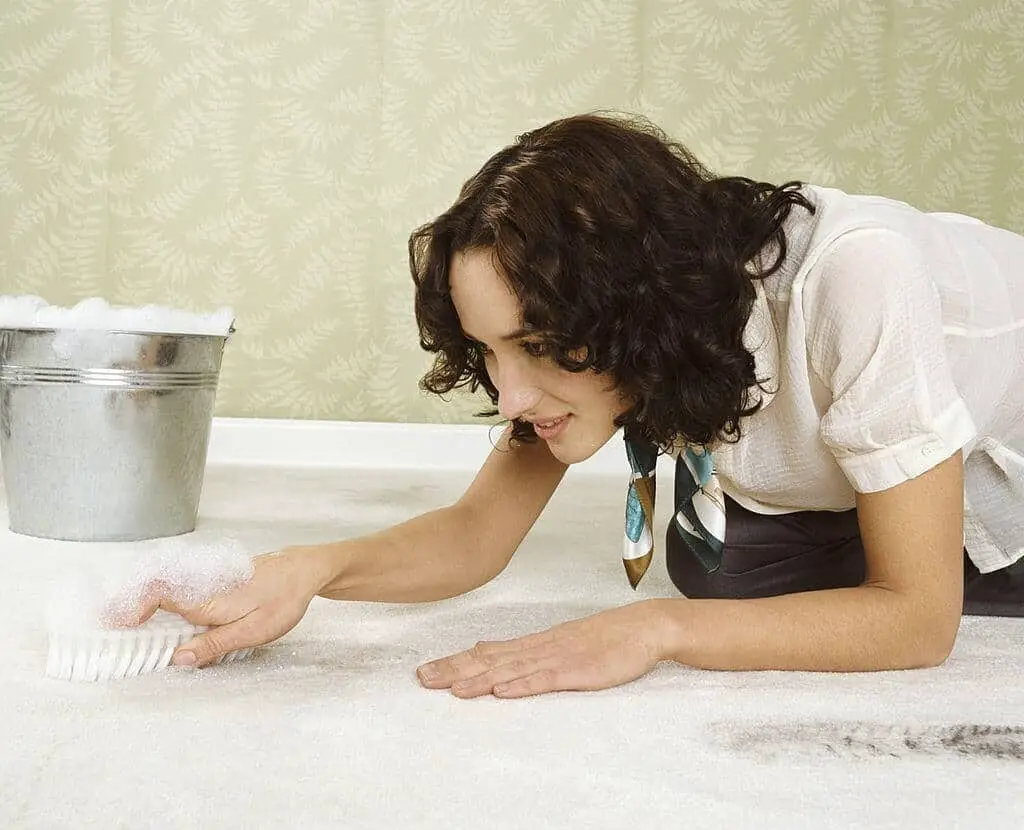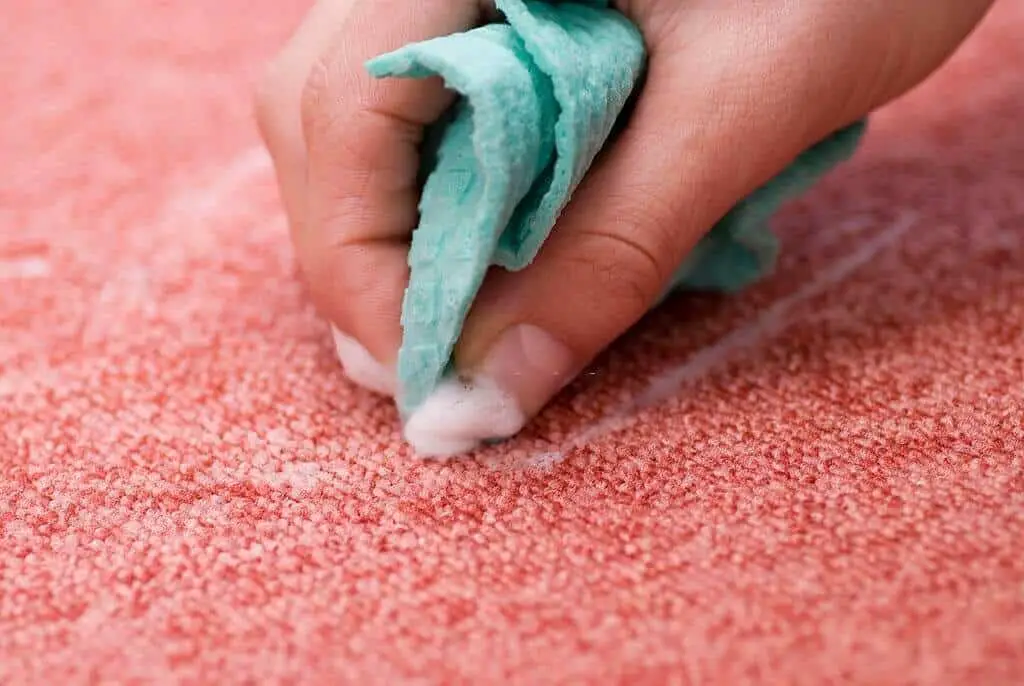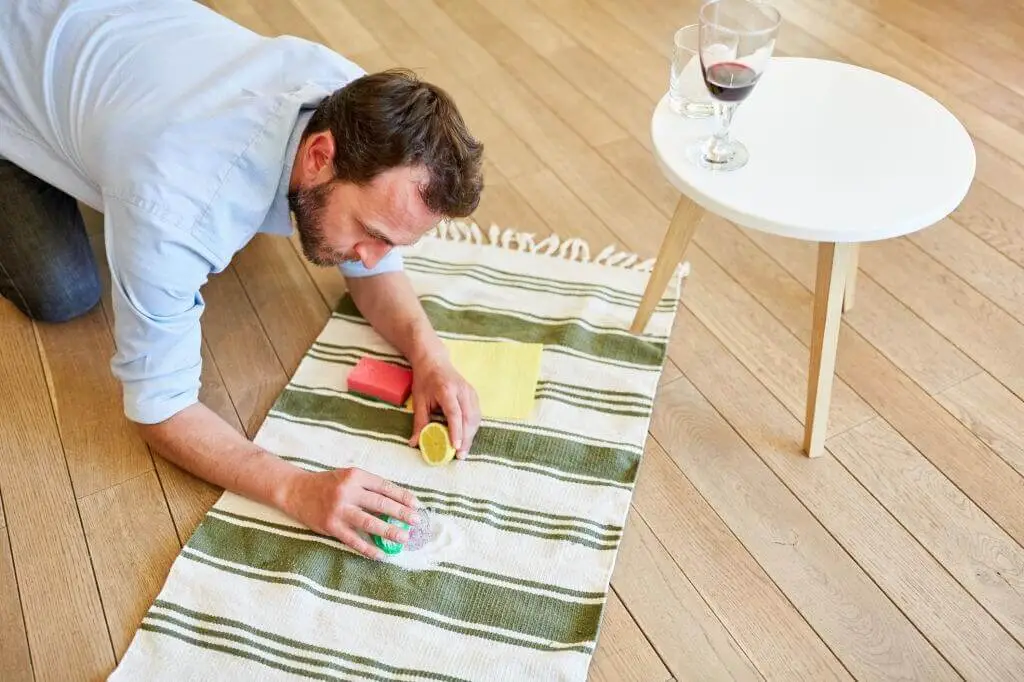If you have kids at home, then you definitely need to know how to get glue out of carpet. Everyone wants a clean plush carpet, but spills happen!
But with proper cleaning techniques and a regular cleaning schedule, your carpet will stay in shape for a long time if you have kids, especially ones who love the craft.
Glue accidents are bound to happen one time or another, so how do you deal with it?
The main problem with glue is that it leaves stains on your carpet, and if not cleaned up immediately, the stain can attract dirt and dust and turn into a mess.
Read: How to get slime out of carpet
So let’s dive into how to get glue out of carpet. With immediate spot treatment, you should be able to get the sticky mess off your floor successfully.
The Type of Glue in Use
Table of Contents
The first step of getting glue stain off your carpet is checking the glue ingredients label to see if it’s water-based or has specific cleaning instructions.
This is because every manufacturer uses a different mix of ingredients. Here are different cleaning strategies for different types of glue.
Craft glue
Craft glue is a water-based adhesive that is mostly used for basic school crafts and art hobbies.
Remove Excess Glue
If you happen to spill it on the carpet, start by removing as much extra adhesive as you can. If the spill is still fresh, pat the spot with a clean rag and soak as much glue as possible.
The lesser the glue, the easier it is to remove the stain, soak as much glue until it no longer lifts out of the carpet.
If the glue has hardened, soak a clean towel in some warm water, then rub on the spot to soften the glue. Make sure the water is warm enough so it can soften the glue adequately.
Apply Some Vinegar
Pour some distilled white vinegar onto a clean cloth or strong paper towel, gently dab it onto the glue and work it in gently, then leave it to settle for about 10 to 15 minutes.
The glue should begin dissolving promptly, once the waiting time is over.
Grab a fresh paper towel or cloth and remove the remaining dissolved glue until the floor is completely cleaned. Ensure to allow the carpet to air dry fully.
A great tip is to test a small amount of vinegar on your carpet and watch the reaction, and this is to make sure vinegar is safe to use on your floor to prevent damage.
You can also use equal parts of water and vinegar, dab it generously on the spot and leave it overnight for better results. Just make sure after using vinegar on your carpet, you allow it enough time to dry.
Read: How to clean a carpet without a vacuum
Dish Soap
Good old dish soap is a great alternative to vinegar, mix some dish soap into some warm water then soak a clean cloth into the mixture.
Then gently scrub the spot, but be very careful not to apply too much pressure so that the glue doesn’t get pushed deeper into the carpet.
Use a separate dry cloth and pat on the spot until it’s dry, then allow to air dry adequately.
Superglue
Superglue is pretty hard to deal with, but like craft, glue tries to remove as much excess glue as possible if the glue has dried up.
Apply some acetone nail polish remover to the spot using a cotton ball, be careful when applying the nail remover, ensure to apply it to the glue only and not on the carpet because if it comes in contact with the carpet, it damages it.
Always work in small sections, and if you notice any reaction or damage on your carpet, drop immediately.
Blot the area using a wet cloth to wipe off excess nail polish, then let it sit for a few minutes.
Apply A Product With D-Limonene
After allowing most of the nail polish and adhesive to be absorbed, take a cleaning product containing d-limonene; it’s an environmentally friendly and natural cleaning product.
You can ask a salesperson at your local retail shop for help on finding the product or do a quick research online.
Make a list, compare and contrast and pick the one that’ll work best for your floor
Using a clean cloth, apply the product to the spot. D-limonene is a safe and natural product, but you can wear gloves if you so prefer.
Ensure to follow the directions and instructions on the product label, allow it to sit on the spot for the directed amount of time.
Dampen a clean cloth, and use it to wipe away any residue left, scrub the area gently and thoroughly because d-limonene tends to leave a residue, you want to make sure there’s no stain left.
Use a gel solvent
There are quite a number of gel solvents in the market you can use in combination with the d-limonene product, apply the solvent, and let it sit on the spot for a couple of minutes.
Use a clean wet cloth and wipe off the gel solvent after letting it sit for a couple of minutes. Pat the area dry with a dry cloth, you may need to reapply the gel solvent if the stain persists.
De-solv-it and goo gone are one of the most popular and recommended gel solvent, as your salesperson in your local retail shop if unsure of which to get.
Read: Pine sol on hardwood floors
How To Remove Adhesive Tape
Remove Excess Tape
Scrap and remove as much tape as you can off the floor, if the tape has a stronghold, pull the tape slowly with your and try to get as many pieces as possible.
Apply Distilled White Vinegar
White vinegar can also be used in removing the adhesive tape, pour the distilled white vinegar onto a cloth and dab the area for at least a minute, making sure to adequately wet the spot, allow the vinegar to sit on the spot for at least 20 minutes.
The vinegar will cause the tape to start peeling off easily and quickly. Using a wet cloth, remove any adhesive left and allow the spot to air dry.
Make sure to use only distilled vinegar and test it out on a small area before using it on larger areas, and this is to prevent any damage to your carpet.
Better still, you can use equal parts of vinegar and water, but you might need to let it sit overnight for better results.
Apply WD-40
To start, scrap the carpet with a paint scraper or plastic knife to remove as much tape as possible. Apply the WD-40 to the remaining adhesive tape on the spot and let it sit for 10 to 15 minutes.
Afterward, scrap the carpet again to remove as much tape as possible. Then finally, apply a carpet cleaner to finish the cleanup.
Make sure the WD-40 will not damage or stain your carpet by testing it out on a small hidden area like behind the couch before applying it to large or visible areas.
Another important tip is not to leave the WD-40 on your carpet for longer than 20 to 30 minutes, leaving it longer than that will weaken the glue used to hold your carpet down.
Apply Rubbing Alcohol To The Area
Soak a paper towel or a clean cloth with rubbing alcohol, then dab it onto the carpet. Begin rubbing it gently to remove the adhesive residue, if the adhesive tape is stubborn or harden.
Lay the rubbing alcohol-soaked cloth or paper towel over the spot for about 15 minutes before rubbing.
Always test the product in a small hidden area before using, vodka is a good alternative to rubbing alcohol.
Use an Iron
Plug in an iron and set it to the highest steam setting. Place a towel over the spot, then once the iron has reached the appropriate temperature, iron over the cloth for not more than 10 seconds, remove the cloth, and the adhesive tape should be transferred onto the towel.
Be very careful when working with a hot iron, and the towel is very important to prevent your carpet from burning. And make sure to test out a small area first.
Call on Professionals
If all these procedures fail, you may need to call on professionals to steam clean because sometimes adhesive is very difficult and tiresome to remove on your own.
If you have exhausted all cleaning options and the adhesive is still present, you may need to hire someone who has knowledge and experience on adhesive removal.
They also have the experience to manage things effectively and quickly, and they can also give you useful tips on how to maintain and keep your carpet clean.
They are multiple cleaning companies in service, do some research, and find the right one for yourself, do well to select the one with a good mix of affordable prices, experience, and reputation.
Make sure to enquire about the type of cleaning products they will be using, if you prefer only environmentally friendly cleaning products, make them aware of that on time.
Hot Glue
If, while using your glue gun, it drips hot glue on your carpet, do not attempt to wipe it immediately as that will only spread the glue and make the stain worse.
Grab a thin piece of cloth, something the glue can stick to, then rub an iron over the cloth; this will transfer the hot glue from the carpet to the cloth.
If the glue has dried on the carpet, this method will also work, as the heat of the iron will melt the glue and then transfer it to the cloth
Gorilla Glue
Gorilla glue is a polyurethane-based glue, which makes getting rid of it from your carpet a hit difficult.
On other flooring surfaces like vinyl or tile, gorilla glue can be removed by acetone, but using acetone on a carpet can eat up the carpet backing and damage it.
It is recommended to cut away the stained spot on the carpet if your carpet has enough pile. But most people prefer patching the carpet, cutting the spot with the glue away, and patching it up with a similar carpet.
Wood Glue
Depending on the type of wood glue, it can be as difficult to remove as gorilla glue, but it can be removed with a solvent in most cases.
Apply a small amount of solvent to the glue stain, lay a dry towel over it, then place an iron set to medium heat over the towel to loosen the glue, then rub it loose gently.
Repeat these processes until you get all the glue out of the carpet, then clean with soap and water.
Hair Glue
Removing hair glue from your carpet is dependent on the type of glue you are using. If the glue is water-based, you can use a solution of vinegar and water and gently scrub it off.
If it’s not water-based, you can use a solvent like acetone, but the downside to using acetone is that it can destroy your carpet backing.
Dab the stained area gently with acetone, let it sit for a couple of minutes, and then wipe it off.
Read: How to get wrinkle out of carpet without a carpet stretcher
Conclusion
The process on how to get glue out of carpet is dependent on the type of glue you are dealing with, hopefully, as you clean up the glue stain, you won’t have to patch or totally replace the carpet.
Trying one or more of the above-mentioned methods should help get rid of glue stains off your carpet.
If you can remove the glue yourself, be sure to call a professional, so as not to ruin your carpet. Have you removed glue from your carpet before? Let us know how it went.


